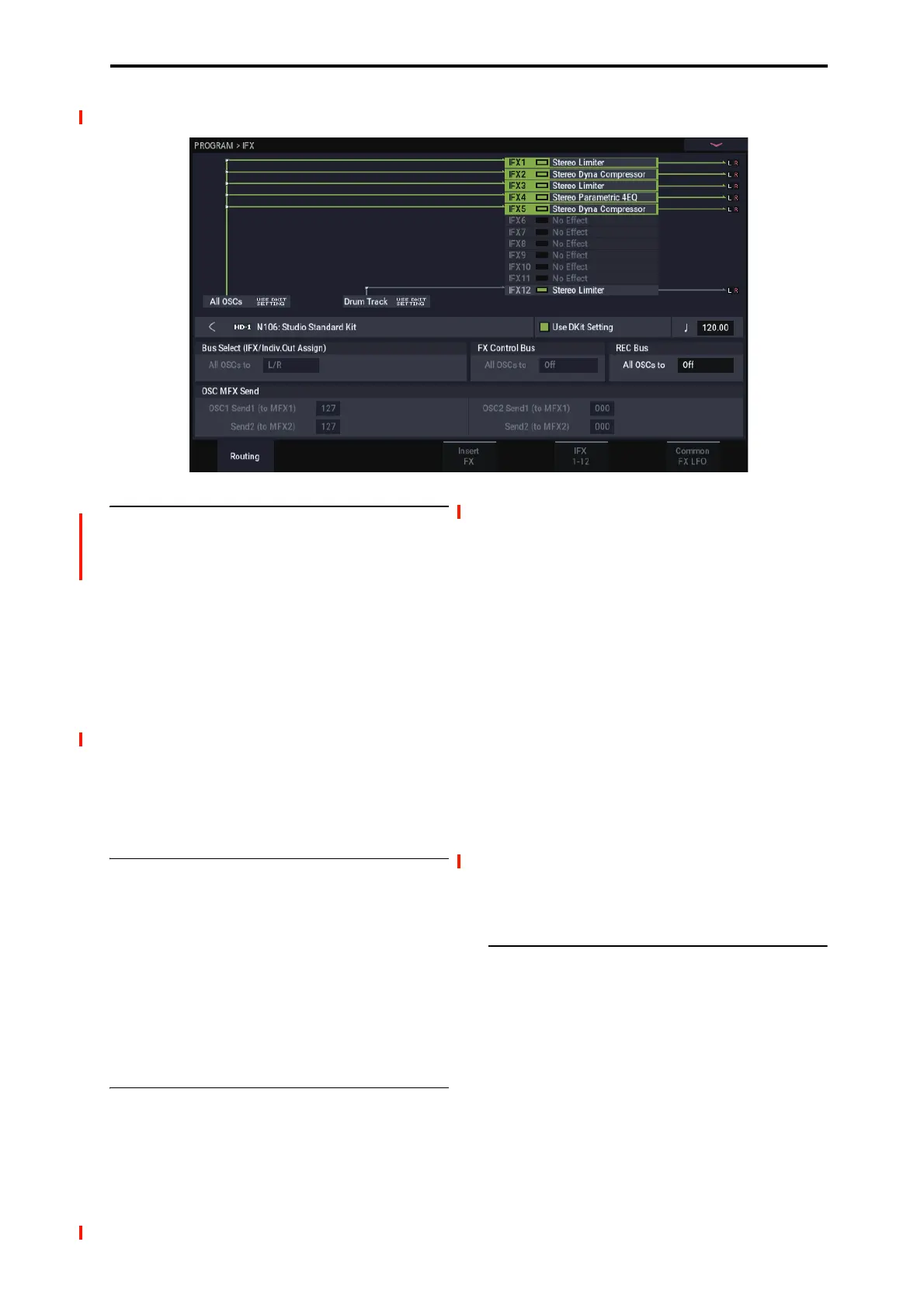PROGRAM > IFX 8–1: Routing
99
Use Dkit Setting = On
8–1c: Bus Select
Bus Select (IFX/Indiv.Out Assign) (All OSCs to)
[L/R, IFX1...12, 1...4, 1/2, 3/4, Off]
This specifies the output bus for both oscillators 1 and 2.
L/R: The oscillators will go to the L/R bus. This is the
default setting.
IFX1…12: The oscillators will go to the specified IFX bus.
1…4: The oscillators will be routed in mono to the specified
AUDIO OUTPUT (INDIVIDUAL).
1/2…3/4: The oscillators will be routed in stereo, using the
Pan setting (4–1c, 4–5: Amp2/Driver2), to the specified
AUDIO OUTPUT (INDIVIDUAL) pair.
Off: The oscillators will not go to any of the outputs directly.
You can use this to route the sound completely through the
MFX. Use Send1 (to MFX1) and Send2 (to MFX2) to
specify the send levels.
8–1d: FX Control Bus
All OSCs to [Off, 1, 2]
Sends the output of oscillators 1 and 2 to an FX Control bus
(two-channel stereo FX Ctrl 1 or 2).
Use the FX Control busses when you want a separate sound
to control the audio input of an effect. You can use two FX
Control busses (each is a two-channel stereo bus) to control
effects in various ways.
For more information, please see “FX Control Buses” on
page 733.
8–1e: REC Bus
All OSCs to [Off, 1…4, 1/2, 3/4]
These settings send the output of oscillators 1 and 2 to the
REC busses (four mono channels: 1, 2, 3, 4).
The REC busses are dedicated internal busses for recording,
used for sampling in the various modes or for recording
audio tracks in SEQUENCER mode.
In PROGRAM mode, you can resample your keyboard or
Arpeggiator performance, or sample an external audio signal
from the AUDIO INPUT jacks.
In order for you to sample, Source Bus must be set to a REC
bus.
Normally you will set Source Bus to L/R so that you can
sample the signal of the L/R bus line, such as your keyboard
or Arpeggiator performance. However, you can use a REC
bus if you want to sample only an audio input while
performing on the keyboard or Arpeggiator function which
are being output via L and R. If desired, multiple audio
inputs can be mixed to a REC bus, or the direct signal from
an audio input can be mixed to a REC bus along with the
sound from an insert effect and sampled. For more
information, see the diagram “Source Bus = REC Bus 1/2”
on page 23.
Off: The signal will not be sent to a REC bus. This is the
default.
1…4: The oscillators will be sent to the specified REC bus,
in mono. The Pan settings (4–1c, 4–5: Amp2/Driver2) will
be ignored.
1/2, 3/4: The oscillators will be sent in stereo to the selected
pair of REC busses.
8–1f: OSC MFX Send
OSC1 Send1 (to MFX1) [000…127]
Sets the volume (send level) at which the output of oscillator
1 will be sent to master effect 1. This applies only when Bus
Select (8–1c) is set to L/R or Off.
If Bus Select is set to IFX1–IFX12, the send levels to
master effects 1 and 2 are set by Send 1 and Send 2 (8–5a)
after passing through IFX1–12.
OSC1 Send2 (to MFX2) [000…127]
Sets the volume (send level) at which the output of oscillator
1 will be sent to master effect 2 (see “OSC1 Send1 (to
MFX1)”).

